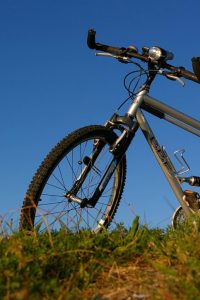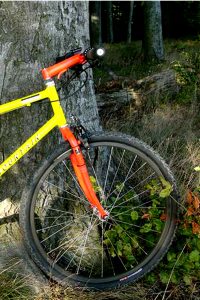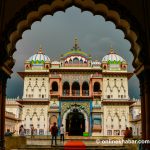
James Giambrone is one of those pioneers who prefer to keep a low profile, remaining in the shadows even as the venture they pioneered becomes popular. Although he is relatively well known in Kathmandu as the director of the Indigo Art Gallery, Giambrone has contributed immensely to mountain biking. He began simply by riding his mountain bike around Kathmandu. He was one of the original gear wallahs, a moniker the locals gave to anyone riding a mountain bike. Giambrone also ran a company that organised cycling trips to the sacred sites of Kathmandu and, occasionally, to places as far-flung as Dang in western Nepal. He also introduced cycling races in Nepal. A staunch believer in the athletic prowess of Nepali mountain bikers, Giambrone’s contribution to the development of mountain biking has gone virtually unnoticed. He recounted those early days of biking in the Sylvan Valley to Kapil Bisht.
When did you first come to Nepal and why?
After my military service in South Korea and returning to my work at Dean Witter in LA, I became politically aware of the inequality of the American system and the ways of corporate America. I joined the protest movement against the Vietnam War, became aware of the power/abuse of the drug industry, the exploitation of the environment, the racism that existed in the USA and became a counterculture child of the 60s.
I first came to Nepal in 1970 while travelling to my mother’s village in Naples, Italy. While living in California I was through with corporate America and decided to hitchhike around the world and started off purchasing a one-way economy passage to Japan aboard the USS President Wilson. I vowed to never take a plane but travel by land or sea—aboard anything that was going in my direction because I wanted to experience other countries and cultures. Asia was so profoundly different than my own country I thought this would suitably launch me on my adventure and be easier on the pocket as well. Thus started my life as a self-proclaimed ‘Counterculture Ambassador’ for the USA.
Sitting atop a bus while cresting the pass at Nagdhunga into the Kathmandu Valley was everything I had imagined, and more. After hearing all the tales from travellers whom I crossed paths with on the road heading to Japan and while I was heading to Europe my head was full of stories of India and Nepal: from the exotic people who lived there to the holy sadhus to the temples and the beauty of the Kathmandu Valley and the mighty Himalayas.
One man told me to make sure I went trekking. Bless his soul because that was so important to understanding Nepal! It all sounded so exciting and many encouraged me to fly now directly to Kathmandu before it was too late. It was changing fast, they said. Haha!
You hitchhiked around the world. What made you choose Nepal for a base?
My first trip to Nepal, in 1970, was for four months—one month out of which was spent in Shanta Bhawan recuperating from hepatitis. I also went trekking to Jomson for two weeks, then hung around and took off for India, where I stayed for most of 1971, returning to Nepal in late ’71.
Upon my return, I opened The Print Shop and Art Gallery in Jhonchhe Tole (it was not called Freak Street back then) with the remaining money I had and sold Tibetan and Nepali woodblock prints to tourists. I went often as I could on treks but was living on the income of the gallery which was very limited, so I could not be gone for very long. I trekked to Namche, Gosainkunda and Langtang in 1973.
I also did a lot of off-road touring on my 1952 BMW. I rode it on the new Kathmandu–Pokhara road in ’73 just after its opening, and dumped it while trying to cross a stream but that’s another story and I drove around the valley on trails!
I stayed on until March ’74, when I left with an eye problem and temporarily gave the shop and my 1952 BMW to a friend, saying I’d be back in a year! I was also in love with a woman who came to live with me in Kathmandu and I wanted to pursue the relationship with the hopes she would move back to Kathmandu with me.
During this period, I photographed and researched Nepali Thanka painting and made a photo documentation of the Swoyambhu Stupa for my visa at Tribhuvan University.
When I returned in 1980, I had plans to make a contemporary traditional Newar arts exhibition in the US, showcasing the best artists of Nepal. I ran out of money and applied for the job of manager of the American Club at Phora Durbar. I also became director of the Indigo Gallery to support the traditional arts of Nepal. I worked both jobs at the same time.
I worked at Phora Durbar until 1990, then led treks, started to do research on my own and to document the traditional arts of the Newars. I was also managing director of Himalayan Mountain Bikes for a couple of years. I bought the company in 1992. So I have had many jobs in Nepal—director, trek leader, art researcher, and WFP photographer/videographer.
When did you first begin mountain biking here in Kathmandu? Talk us through those early days.
I rode my first mountain bike around 1984/85. There was an abundance of single track in the Kathmandu Valley back then. It was before many roads were cut into the landscape for the expansion of motorable roads.
What was the Gear Wallahs? How did it come about? What did it do?
When I rode on the trails in the Valley, young children used to yell out “gear wallah aayo!” and I thought it was a perfect name for a club. That is how Gear Wallahs Kathmandu got its name. As taking on the unopposed position of president I decided to have an initiation ride up to Kakani by the full moon and camp out on the British Bungalow grounds. Of course, I/we would slip wine bottles into the unsuspecting initiate’s panniers or backpack or a rock now and then only to the amusement of us all when asked if anyone had brought a bottle of wine or was feeling like they were carrying stones up the mountain.
It was a select group of bikers and we did not solicit members but only those who were deemed in our eyes as worthy and fun to be with. No bashers of all things Nepali were allowed: we all loved being here and enjoyed the pristine valley.
In 1992, you bought Himalayan Mountain Bikes from Francis Higgins. What were your plans when you took over the company?
By 1994, I was biking for almost ten years and was earmarked to write the first guidebook on mountain biking in Nepal. It was published in 1994. The book was entitled Follow Me: Kathmandu Bikes & Hikes, and was published by APA Insight Pocket Guides, Hong Kong. It was a natural fit that I would own a bike company but little did I learn about how hard it was to get back on the bike when you were the managing director of the company. So I had to hire and train guides and do a lot of office work marketing for the company. I saw this sport as a great fit for the adventure market which already had mountaineering, rafting and trekking and the Tragopan Annapurna Triathlon in Pokhara. But we were way too early and it was a struggle to compete with these established activities. The tourist market was still used to cheap trips and bike equipment was expensive.
It seems that you did well, because within a couple of years you were chartering helicopters to fly clients to Mustang from where they cycled down to Pokhara. Was that a particularly good time for cycling as a tourist activity in Nepal?
Well, it helped that the group, 25 pax, were expat CEOs of Asian businesses out for their yearly adventure, but groups like that were rare. The 90’s were way too early and I pitched the helicopter idea for the race to Dick Tuttle of Nepal Travelers and he liked it and supported us. The private sector can be the big players in travel adventure and are starting to do that but we need much more.
You were the first to organise cycling races and triathlons. What did you hope to achieve through them?
I’ve always been an active person all my life and saw this opportunity to involve the Nepali people in something that was healthy and they would be good at. Also that it would benefit the Nepal economy by bringing adventure tourists to Nepal. Nepal is a ripe playground for adventure tourism and has grown into that role, which is fantastic!
These events must have had a big influence on young Nepalis who eventually took to the saddle. Do you think the sport has grown as much as it should have in Nepal?
Yes, it has but could be much bigger if the Nepal Government opened up the possibilities of creating more mountain bike trails within the Kathmandu Valley. They could do that in Shivapuri, Nagarjun, and in places south of the valley. I’m talking single tracks here.
Do you think there are enough races in Nepal to allow bikers to develop as professionals?
No, there are not enough races. You need to race every weekend to develop into a professional racer. You need private sector patronage to put up funds for prizes, team sponsorship, etc. That way kids can see there is a goal to aim for. Being on the mountain bike team at the Olympics, Asian Championships, national championships takes lots of training, proper diet, and full sponsorship.
What kind of races would you like to see in Nepal?
More off-road races that can be filmed for sponsors by doing a multiple lap system so they can get coverage for their company, you need to give them lots of coverage for TV and commercial advertisements.
Also, stage races such as on mountain bikes with skinny tyres. For instance, first stage: KTM-Daman; second stage: Daman-Muglin; third stage: Muglin-Pokhara. This takes a lot of organisation but it is possible if Nepal wants to do it. There should be mountain bike festivals, with trial sections, races, crazy costume events and a big party! Getting together people who love to ride and race is another thing that needs to be done here.
You’ve always said that Nepalis are endowed with the ideal physique to excel as mountain bikers. What more would they need in order to challenge and win at the international level?
Sponsorship for diet, training, equipment, international race attendance and prize money offered to riders.
How closely do you follow the mountain biking scene in Nepal now?
Only on Facebook when I hear about it.
What role can the government and the corporate sector play in developing young talent?
Races, races and races with prize money!
Have you had any experiences of dealing with the corporate sector here for raising funds or sponsoring a mountain biker? What is it that is keeping them from sponsoring mountain bikers even when some Nepali bikers have proven themselves on the international stage?
I worked with Dick Tuttle who ran the casinos and Nepal Travelers magazine and he sponsored the first helicopter video of our race from Kakani to Budhanilakanta.
Local sponsorship are difficult because I think they don’t see themselves benefitting in the international market. But I do believe that is changing now, although very slowly. We need more sanctioned races locally with TV coverage, cash prizes to entice the local businesses into co-operating sponsorship. They need their names seen on local TV, at the cinema hall commercials. They also need to be more mindful of the positive influence they can have on the youth of Nepal. That is something they need to act on.




















